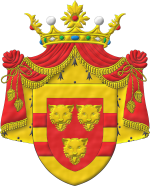Soulouque’s process of obtaining absolute power in Haiti culminated in the formation of the Second Empire of Haiti after the Senate and Chamber of Deputies proclaimed him Emperor of Haiti on 26 August 1849, re-establishing the Haitian empire that had been abolished in 1806 following the assassination of Jean-Jacques Dessalines, who served as Emperor Jacques I of the First Empire of Haiti (another monarchy, the Kingdom of Haiti, existed in 1811-1820). Soulouque paid £2,000 for his crown, and spent £30,000 for the rest of the accessories (according to Sir Spenser St John, British charge d’affaires in Haiti during the 1860s in his account: Hayti, or, The Black Republic, pp. 95–96). Gustave d’Alaux describes this event in his book, Soulouque and his Empire: “His Imperial Majesty had the principal merchant of Port-au-Prince called one morning and commanded him to order immediately from Paris a costume, in every particular like that he admired in representing the ceremonies of the coronation of Napoleon. Faustin I besides ordered for himself a crown, one for the Empress, a sceptre, globe, hand-of-justice, throne, and all other accessories, all to be like those used in the coronation of Napoleon.”.
In December 1849, Faustin married his long-time companion Adélina Lévêque. On 18 April 1852 at Port-au-Prince, both Emperor and Empress were crowned in an immense and lavish ceremony in emulation of the coronation of Napoleon. The president of the Senate attached to the breast of the Emperor a large decoration, passed a chain about the neck of the Empress – and pronounced his address, to which His Majesty Faustin replied with spirit: “Vive la liberté, vive l’égalité!” (Gustave d’Alaux). The coronation is illustrated in the Album Impérial d’Haïti, engraved by Severyn, published New York, 1852 (available in the British Library).




